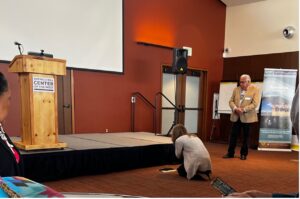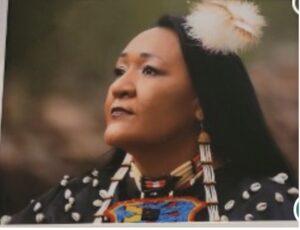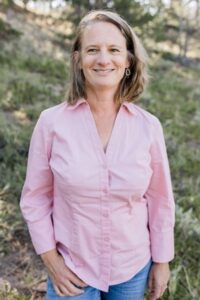By: Yufna Soldier Wolf, Indigenous Land Alliance of Wyoming, & Deb Kleinman, Collaboration Program in Natural Resources/Lupine Collaborative

At the Building Bridges Symposium in Cody on April 14, 2022, over 50 people gathered from across Wyoming and neighboring states representing Native Nations, federal and state agencies, and nonprofit organizations. The convener was the Collaboration Program in Natural Resources (CPNR) out of the University of Wyoming, which has the mission of increasing collaborative capacity in Wyoming and the West. CPNR partnered closely with the Indigenous Land Alliance of Wyoming (ILAW) to design and host the event.
CPNR and ILAW sought to cultivate connections that would support enduring and sustained collaborative efforts to solve complex shared environment and natural resource challenges and to engage Tribal leaders as full and equal partners in the process.
Throughout the day, we invited people to introduce themselves more broadly than they might normally do and to root their introductions in the symposium themes of place, people, and practice. These interwoven themes of the day grounded each participant in the core principles of doing cross-cultural collaborative work.
Get notified when new articles are posted to the EDR blog – sign up for our email list »
In many Tribal cultures, introductions are about the collective. It allows individuals to honor those who came before and who support them, and to honor every person who has had an impact on their lives. This is particularly important for Tribal elders, who often take a longer time for introductions than might be usual practice for those coming from non-Tribal organizations. For this and other reasons, the day was designed with enough space and time for these stories to be told.
Place: The theme of place had several interconnected dimensions, relating both to where we gathered and where participants (and their ancestors) came from. The symposium took place in Cody, Wyoming. For thousands of years, the greater Yellowstone area has had deep significance for over 20 Tribes. Meeting in this region instead of in less neutral parts of the state (including the Wind River Reservation) meant that both Northern Arapaho and Eastern Shoshone participants would feel welcome. The geographic location and the specific venue were both crucial in creating a safe and welcoming environment for all who came.
People: We strove for balance in the stories told throughout the day. Facilitators (which included Tribal and non-Tribal leaders) made explicit choices about the agenda and the schedule so that responsibility for guiding discussion was shared. We worked hard to replicate that balance and reciprocity in each panel discussion and group conversation. In addition, each of the partner organizations worked with their respective networks to ensure that there were a range of perspectives and voices. To ensure that Tribal leaders could attend, the Ruckelshaus Institute generously covered travel costs and provided honorariums.
Practices: Here are a few things we learned about planning and facilitating the event that contributed to the success of the day:
Design the Agenda to Serve the Purpose: We did our best to design the day in support of the central purpose: connection and cross-cultural awareness. It was crucial that we had the ability to be fluid and flexible. We wanted speakers and participants, in particular the Tribal elders, to have the space and time to tell whatever stories they wanted and needed to share.
Opening and Closing the Gathering: Ivan Posey, the Tribal Education Coordinator for Central Wyoming College and an E. Shoshone tribal leader and elder, graciously offered an opening blessing and a closing prayer. This felt appropriate because it indicated to all present, especially the Tribal partners, that this symposium was about cultivating connection and trust and deepening cross-cultural awareness. Opening a gathering in such away will look different for each Native Nation. Note that if burning cedar or sage as part of these ceremonies, notify the facilities staff at your venue.
Redefining Productivity and Success: It was important to expand the definition of success for this event. Our goal wasn’t to jump right in and answer questions or make linear progress towards an undefined milestone – we didn’t even know yet what the questions were going to be. We wanted introductions, stories, relationships, and ideas first – that was the “work” that needed to “get done.” We recommend for organizations and agencies that come into a new partnership with Tribes to take time to establish connections, trust, and cross-cultural awareness first before addressing goals and objectives.
Equitable and Safe Dialogue: We wanted to cultivate connections, build trust, and share stories. We did not want a day where people listened to lectures that could have been delivered virtually. Panelists and speakers received high level questions ahead of the event (developed collaboratively by the organizers) so they knew in broad strokes what they were signed up for, but these questions were moderated with a very light hand.
We wanted to create opportunities for people to ask questions they were afraid to ask, and for everyone present to be as real and vulnerable as they wanted or needed to be. We also wanted to avoid the all-to-common pitfall of a few participants asking long performative questions and dominating the discussion. Questions were primarily solicited through small group discussions at round tables and through index cards collected by the moderators, not through a stand-up microphone at the front of the room.
What Comes Next: At the end of the day, we asked participants to brainstorm ways that would continue building on the connections and relationships established at this event. Suggested next steps included a wide range of ideas and actions: invitations to visit buffalo herds on the Wind River Reservation, offers of mutual support and aid between Tribal and non-Tribal entities, ongoing discussions about education and job opportunities for Tribal youth, and holding future events and continuing to deepen the dialogue. One concrete step taken by the Ruckelshaus Institute coming out of the symposium is to provide financial support to Native American participants in CPNR for the 2022 cohort.
At the end of the day, our hope is that the Building Bridges represents a real and meaningful beginning of greater shared understanding, connection, and reciprocity when it comes to environmental collaboration in Wyoming and the West. As with land acknowledgements, however, it is what we do next that will have the greatest impact.
Hohou! Aise! Thank you!
See here for a video compilation of the symposium.
 Yufna Soldier Wolf was born and raised on the Wind River Reservation. Her name actually means Mother Nature’s Child. She is a citizen of the Northern Arapaho and has Cheyenne and Lakota ancestry. Her heart and passion is for preservation of tribal ways and customs, which includes protecting the land and her ancestors. Yufna has received various degrees, accolades, and certificates from Montana State University and the University of Wyoming. One degree she is proud of is the Indigenous Studies degree she recently completed at the University of Wyoming. She is working towards a master’s from Montana State in Indigenous Studies with a specialization in sovereignty. Yufna gained experience as the former Northern Arapaho Tribal Historic Preservation Officer as well as the Native American Graves Protection and Repatriation Act Manager. Her education and experience humble her and she is always looking for ways to improve and sustain life for future generations. Yufna lives and breathes Wind River. Yufna is happy to be a team member at the Wyoming Outdoor Council.
Yufna Soldier Wolf was born and raised on the Wind River Reservation. Her name actually means Mother Nature’s Child. She is a citizen of the Northern Arapaho and has Cheyenne and Lakota ancestry. Her heart and passion is for preservation of tribal ways and customs, which includes protecting the land and her ancestors. Yufna has received various degrees, accolades, and certificates from Montana State University and the University of Wyoming. One degree she is proud of is the Indigenous Studies degree she recently completed at the University of Wyoming. She is working towards a master’s from Montana State in Indigenous Studies with a specialization in sovereignty. Yufna gained experience as the former Northern Arapaho Tribal Historic Preservation Officer as well as the Native American Graves Protection and Repatriation Act Manager. Her education and experience humble her and she is always looking for ways to improve and sustain life for future generations. Yufna lives and breathes Wind River. Yufna is happy to be a team member at the Wyoming Outdoor Council.
 Deb Kleinman was born in Colorado and raised in Michigan. Her father’s parents immigrated to the US from the Ukraine at the turn of the last century, and her mother’s family originally arrived from Scotland and Ireland some time before that. Deb has lived in many places across the country, but has called the Rocky Mountains home since 2004. These days, she lives in Laramie, WY with her husband and two dogs. Deb helps groups connect, communicate and collaborate through her work as a facilitator, trainer, and coach under the Lupine Collaborative umbrella. She also serves as the Director of the Collaboration Program in Natural Resources at the University of Wyoming. Deb currently serves as Co-Chair of the Environment and Public Policy Section of the Association for Conflict Resolution, and volunteers as a leadership coach for the Regional Institute for Health and Environmental Leaders. Deb is thrilled to be able to cultivate spaces and places where these kinds of dialogues can occur.
Deb Kleinman was born in Colorado and raised in Michigan. Her father’s parents immigrated to the US from the Ukraine at the turn of the last century, and her mother’s family originally arrived from Scotland and Ireland some time before that. Deb has lived in many places across the country, but has called the Rocky Mountains home since 2004. These days, she lives in Laramie, WY with her husband and two dogs. Deb helps groups connect, communicate and collaborate through her work as a facilitator, trainer, and coach under the Lupine Collaborative umbrella. She also serves as the Director of the Collaboration Program in Natural Resources at the University of Wyoming. Deb currently serves as Co-Chair of the Environment and Public Policy Section of the Association for Conflict Resolution, and volunteers as a leadership coach for the Regional Institute for Health and Environmental Leaders. Deb is thrilled to be able to cultivate spaces and places where these kinds of dialogues can occur.
